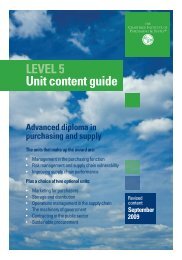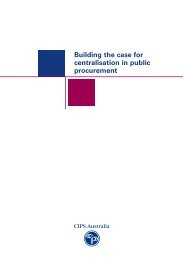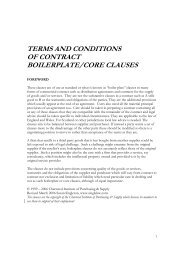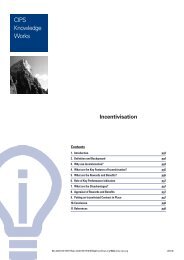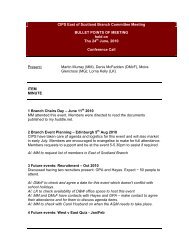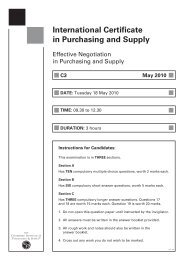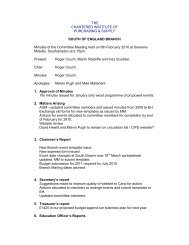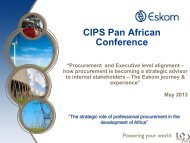Graduate diploma - The Chartered Institute of Purchasing and Supply
Graduate diploma - The Chartered Institute of Purchasing and Supply
Graduate diploma - The Chartered Institute of Purchasing and Supply
Create successful ePaper yourself
Turn your PDF publications into a flip-book with our unique Google optimized e-Paper software.
1.0 RELATIONSHIPS WITH<br />
STAKEHOLDERS<br />
RELEVANT TO PUBLIC<br />
PROCUREMENT.<br />
(Weighting 30%)<br />
1.1 Identify <strong>and</strong> evaluate<br />
critical internal <strong>and</strong><br />
external stakeholders<br />
relevant to public<br />
procurement<br />
• Rationale for distinguishing<br />
between internal <strong>and</strong><br />
external stakeholders<br />
• Internal stakeholders:<br />
clients, budget holders,<br />
finance, audit<br />
• External stakeholders:<br />
elected representatives,<br />
suppliers, trade unions,<br />
industry organisations,<br />
community groups.<br />
1.2 Assess the role, interests<br />
<strong>and</strong> resources <strong>of</strong> internal<br />
<strong>and</strong> external stakeholders<br />
in relation to procurement<br />
• Stakeholder identification<br />
model - Mendelow (1991)<br />
• Stakeholder analysis<br />
methods <strong>and</strong> systems<br />
• Weighting the resources<br />
<strong>and</strong> influence <strong>of</strong><br />
stakeholders.<br />
1.3 Analyse approaches for<br />
influencing <strong>and</strong> managing<br />
stakeholders by engaging<br />
them at an early stage in<br />
procurement plans <strong>and</strong><br />
specific strategic<br />
procurements<br />
• <strong>The</strong> benefits <strong>of</strong><br />
incorporating stakeholders<br />
into the planning process<br />
at an early stage<br />
• Managing diversity<br />
amongst stakeholders<br />
• Reasons for project failures<br />
where stakeholders were<br />
not fully informed.<br />
1.4 Critically evaluate<br />
communication <strong>and</strong><br />
collaborative strategies<br />
that may be developed to<br />
improve relationships with<br />
internal <strong>and</strong> external<br />
stakeholders<br />
• <strong>The</strong>ories, models, policy<br />
documents <strong>and</strong> practice in<br />
relation to communication<br />
<strong>and</strong> collaborative<br />
strategies<br />
• <strong>The</strong> importance <strong>of</strong><br />
developing communication<br />
<strong>and</strong> collaborative<br />
strategies to improve<br />
relationships<br />
• <strong>The</strong> concept <strong>of</strong> shared<br />
services in the public<br />
sector.<br />
48<br />
1.5 Critically assess the<br />
effectiveness <strong>of</strong> the<br />
purchasing organisation’s<br />
internal <strong>and</strong> external<br />
communications policy<br />
<strong>and</strong> processes<br />
• How to devise <strong>and</strong> apply<br />
tests <strong>of</strong> communication<br />
effectiveness<br />
• <strong>The</strong> importance <strong>of</strong><br />
demonstrating the<br />
effectiveness <strong>of</strong> chosen<br />
communication policies<br />
<strong>and</strong> processes<br />
• Methods <strong>of</strong> review <strong>of</strong><br />
communications in<br />
comparable organisations<br />
• Learning from examples <strong>of</strong><br />
effective communications<br />
demonstrated in other<br />
sectors <strong>and</strong> industries.







